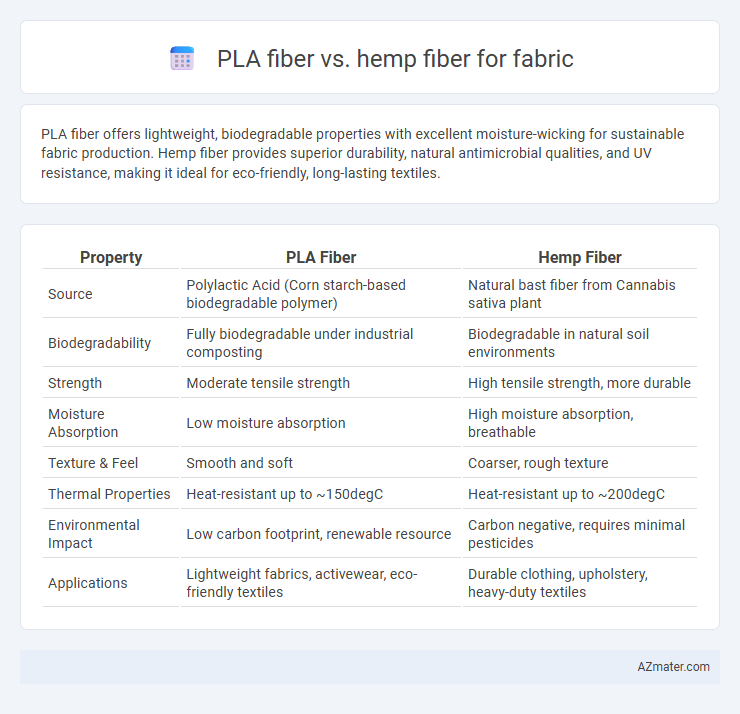PLA fiber offers lightweight, biodegradable properties with excellent moisture-wicking for sustainable fabric production. Hemp fiber provides superior durability, natural antimicrobial qualities, and UV resistance, making it ideal for eco-friendly, long-lasting textiles.
Table of Comparison
| Property | PLA Fiber | Hemp Fiber |
|---|---|---|
| Source | Polylactic Acid (Corn starch-based biodegradable polymer) | Natural bast fiber from Cannabis sativa plant |
| Biodegradability | Fully biodegradable under industrial composting | Biodegradable in natural soil environments |
| Strength | Moderate tensile strength | High tensile strength, more durable |
| Moisture Absorption | Low moisture absorption | High moisture absorption, breathable |
| Texture & Feel | Smooth and soft | Coarser, rough texture |
| Thermal Properties | Heat-resistant up to ~150degC | Heat-resistant up to ~200degC |
| Environmental Impact | Low carbon footprint, renewable resource | Carbon negative, requires minimal pesticides |
| Applications | Lightweight fabrics, activewear, eco-friendly textiles | Durable clothing, upholstery, heavy-duty textiles |
Introduction to PLA Fiber and Hemp Fiber
PLA fiber, derived from polylactic acid synthesized through the fermentation of renewable resources such as corn starch or sugarcane, offers biodegradable and eco-friendly properties ideal for sustainable fabric production. Hemp fiber, obtained from the stalks of the Cannabis sativa plant, is renowned for its exceptional strength, durability, and natural resistance to pests and UV light, making it a highly sustainable choice for textile manufacturing. Both fibers contribute to reducing environmental impact but differ significantly in source, mechanical properties, and biodegradability timelines.
Origin and Production Processes
PLA fiber is derived from renewable resources such as corn starch or sugarcane through a fermentation and polymerization process, making it a bioplastic-based fiber produced via extrusion and spinning techniques. Hemp fiber originates from the stalks of the Cannabis sativa plant, harvested and processed through retting, decortication, and scutching to extract strong bast fibers suitable for textile production. The PLA fiber production relies on biotechnological synthesis and industrial manufacturing, whereas hemp fiber processing utilizes traditional agricultural methods combined with mechanical treatments.
Environmental Impact Comparison
PLA fiber, derived from renewable corn starch, offers biodegradability and lower carbon emissions compared to conventional synthetic fibers, yet its production relies heavily on agricultural inputs and industrial processing. Hemp fiber, obtained from the Cannabis sativa plant, boasts exceptional sustainability due to minimal water usage, natural pest resistance, and carbon sequestration benefits, making it one of the most environmentally friendly natural fibers. In fabric production, hemp's lower environmental impact stems from its reduced chemical requirements and soil improvement properties, while PLA's biodegradability is limited by specific composting conditions.
Biodegradability and Sustainability
PLA fiber, derived from renewable resources like corn starch, offers biodegradability under industrial composting conditions within 1 to 3 months, making it a sustainable alternative to conventional synthetic fibers. Hemp fiber is highly sustainable due to its low water and pesticide requirements, robust growth, and natural biodegradability, breaking down efficiently in soil within a few months without releasing harmful residues. Both fibers contribute to eco-friendly fabric production, but hemp excels in overall environmental impact due to its minimal cultivation inputs and strong biodegradability in natural conditions.
Strength and Durability
PLA fiber exhibits high tensile strength but tends to have lower durability under prolonged UV exposure and moisture compared to hemp fiber. Hemp fiber is renowned for its exceptional durability, resistance to wear, and natural antifungal properties, making it ideal for long-lasting fabric applications. The natural lignin content in hemp enhances its rigidity and resistance to environmental stress, outperforming PLA fiber in terms of overall fabric strength and longevity.
Comfort and Breathability in Fabrics
PLA fiber offers excellent moisture-wicking properties and a soft, smooth texture that enhances comfort in fabrics. Hemp fiber provides superior breathability due to its natural porous structure, allowing better air circulation and temperature regulation. Both fibers contribute to comfortable, breathable fabrics, but hemp excels in durability and moisture permeability, making it ideal for warm climates.
Dyeing and Color Retention
PLA fiber offers vibrant color absorption and excellent initial dye uptake due to its synthetic polymer structure, making it suitable for bright, uniform dyeing. Hemp fiber, being a natural cellulose-based material, absorbs dyes deeply but often exhibits slower wash-fastness and color retention compared to PLA, especially under prolonged exposure to sunlight and washing. Advanced dyeing techniques like reactive or vat dyes improve hemp's colorfastness, but PLA maintains better long-term vibrancy and resistance to fading in fabric applications.
Cost and Market Availability
PLA fiber generally costs more than hemp fiber due to its synthetic production process involving polylactic acid derived from fermented plant starches. Hemp fiber offers greater market availability as it is a widely cultivated natural fiber known for its sustainability and durability in textile applications. The hemp fiber market benefits from established global supply chains, while PLA fiber is still emerging, limiting its widespread commercial accessibility.
Popular Applications in Textile Industry
PLA fiber is widely used in activewear and sportswear due to its moisture-wicking and breathable properties, making it ideal for performance textiles. Hemp fiber finds popularity in eco-friendly apparel and home textiles, favored for its durability, antifungal qualities, and sustainability. Both fibers are increasingly incorporated in blends to enhance fabric strength and environmental benefits in fashion and interior design sectors.
Choosing Between PLA and Hemp for Fabric
PLA fiber offers biodegradability and moisture-wicking properties, making it suitable for activewear and eco-friendly textiles. Hemp fiber provides superior durability, natural UV resistance, and antimicrobial qualities, ideal for long-lasting, breathable fabrics. Choosing between PLA and hemp depends on the desired fabric performance, sustainability goals, and end-use application.

Infographic: PLA fiber vs Hemp fiber for Fabric
 azmater.com
azmater.com